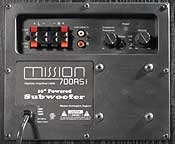Surround Sensations Page 2
The RABOS kit includes a sound-level meter, a screwdriver, measuring templates, and a test-tone CD. These help you measure the sub's acoustic output in your room, then calculate the right frequency, level, and filter-width ("Q") equalizer settings to optimize its performance. You use the screwdriver to dial in the settings on three recessed potentiometers.
 Klipsch Synergy SF-2 The system we assembled from speakers in Klipsch's Synergy series to some extent reflects the "bigger is better" approach this venerable brand was once known for. No bookshelf-size front left/right satellites here - this system sports floor-standing, waist-high SF-2 towers with traditional medium-density-fiberboard (MDF), bass-reflex cabinets and black cloth grilles. The speaker has a proprietary horn-loaded Trac trix tweeter, two woofers, and a rear port.
Klipsch Synergy SF-2 The system we assembled from speakers in Klipsch's Synergy series to some extent reflects the "bigger is better" approach this venerable brand was once known for. No bookshelf-size front left/right satellites here - this system sports floor-standing, waist-high SF-2 towers with traditional medium-density-fiberboard (MDF), bass-reflex cabinets and black cloth grilles. The speaker has a proprietary horn-loaded Trac trix tweeter, two woofers, and a rear port.
The SC-1 center speaker is also fairly conventional looking, though one of the rear corners is angled so the speaker can sit below a screen and be aimed upward. The sealed MDF cabinet houses the same tweet er as the SF-2, but there are two smaller woofers, arrayed symmetrically on either side of it. The SS-1 surround satellite, designed for wall mounting, has a sealed MDF cabinet with drivers deployed across three angled faces. Two contain Tractrix tweeters, radiating 90° apart, and the center face, which is aimed at the listeners, has the same small woofer as the SC-1.
The KSW-12 powered subwoofer has a black MDF bass-reflex cabinet raised on tall feet because its 12-inch driver fires down ward (its port is in the rear). The speak er-level outputs are high-pass filtered at 100 Hz, with 6-dB-per-octave slopes. The sub's low-pass filter is continuously variable from 40 to 120 Hz, with a 24-dB-per-octave slope above 120 Hz. Phase is revers ible, and there's an output-level control and a power switch.
 Mission m70 Series From Mission's new m70 series, we assembled a system starting with the m72, a classic bookshelf speaker with a vented cabinet and a black cloth grille. The woofer and tweeter are both mounted in a single hard plastic casing that's secured to the cabinet with six screws. The rear of the MDF cabinet has the woofer port and four binding posts (so they can be biamplified).
Mission m70 Series From Mission's new m70 series, we assembled a system starting with the m72, a classic bookshelf speaker with a vented cabinet and a black cloth grille. The woofer and tweeter are both mounted in a single hard plastic casing that's secured to the cabinet with six screws. The rear of the MDF cabinet has the woofer port and four binding posts (so they can be biamplified).
The m7c1 center speaker has a black, molded-plastic cabinet whose rounded edg es are meant to flow unobtrusively into the top of a TV set. Its black grille cloth conceals a tweeter, two midrange drivers, and two ports, all horizontally and symmet rically arrayed.
- Log in or register to post comments














































